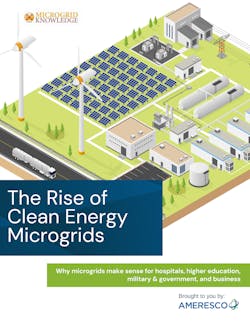When we talk about a community microgrid, we typically mean a larger scale project that benefits an entire community, not just a single customer or building. A community microgrid could be owned and operated by the community itself, by an integrator like Ameresco, or even by an innovative and forward-thinking utility.
Microgrids create new jobs
As the North American energy infrastructure moves toward a more microgrid-driven architecture over the next 10-15 years, microgrid manufacturing, installation and operations will accelerate, which will require skilled, local workers.
Workers will be needed to build wind, solar or other distributed energy resources for large-scale community microgrid projects. After the microgrid is commissioned, experts in control and operations management must be employed. It’s true that the artificial intelligence (AI) used in microgrid control systems can handle a lot of the operations management, but microgrid systems still require on-the-ground experts to handle what AI cannot.
At Ameresco, our mantra has always been to hire locally where we can; sometimes training and developing a local workforce is even part of the scope of work. As microgrid adoption increases, we expect to see waves of new, good paying, renewable energy jobs. Additionally, there will be tremendous opportunities for the regional universities, colleges and vocational schools that are training or retraining the local workforce to fill those openings.
From training to construction, operations and maintenance, a community microgrid can provide a significant number of jobs and improve the economics of the entire area.
Microgrid resiliency attracts new companies to the area
In addition to clean energy jobs, a community microgrid is the perfect opportunity to partner with the local utility to strengthen a community’s energy infrastructure. While some utilities see microgrids as a threat to their business model, others see them as a new tool that can provide reliable, greener electricity to their customers.
Regions with reliable electrical quality — a key benefit of microgrids — are better able to attract new tech and manufacturing businesses. That means more jobs, higher tax revenues for the local government and more opportunities for the community to grow.
For example, the Slemon Park microgrid on Canada’s Prince Edward Island (PEI) is designed to help the community create a thriving commercial industrial hub. Developed in partnership with PEI Energy, the microgrid has a 10-MW solar system and can island from the larger PEI grid in case of an outage.
For a renewables-based microgrid to provide resiliency, you must have an energy storage system in play. Slemon Park’s solar and battery energy storage systems are co-located on-site and share the same utility interconnect. Additionally, individual battery energy storage units are deployed to each leaseholder’s business. The combination of these two energy storage methods provides the long-term, reliable electrical quality that makes the area attractive to businesses looking to relocate.
Download this report on The Rise of Clean Energy Microgrids.
Renewable microgrids attract businesses looking to meet their ESG goals
When a community microgrid includes renewable energy sources, it allows a municipality to make an impact on its environmental commitments and environmental, social and governance (ESG) goals through the reduction of its greenhouse gas emissions. It’s also a great selling feature for like-minded businesses.
This is what’s happening on PEI, which is focused on becoming the first Canadian province to go net zero. The Slemon Park microgrid will help the island achieve that goal by generating reliable, zero emissions electricity.
The microgrid is also attracting companies looking for a way to meet their own climate goals. Relocating to a region that’s on the path to net zero is an easy way to reduce carbon emissions.
Final thoughts
Microgrids provide controllable, resilient and green energy within a local area, and they will be a big part of the infrastructure we need to decarbonize our economy. Further, microgrid proliferation is expected to provide more jobs and a tremendous economic boost to communities across the country.
Jim Fonger is vice president of asset and advanced technology development for Ameresco.










